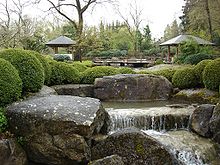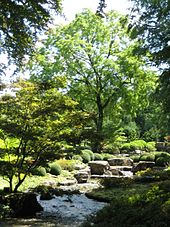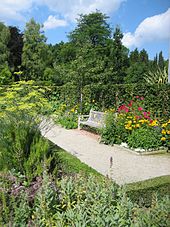Augsburg Botanical Garden
The Augsburg Botanical Garden was built at its current location in 1936 on what was then 1.7 hectares in size, which has now grown to around 10 hectares. The botanical garden is home to more than 3,100 plant species and varieties . The more than one million bulb plants in open spaces and changing beds offer a particularly attractive spring aspect.
location
The botanical garden is located east of the Siebentischpark in the Augsburg city forest . The Dr.-Ziegenspeck -Weg separates the Botanical Garden from the neighboring Augsburg Zoo . Both facilities can be reached in local public transport with bus line 32 of the Augsburg public transport company and have parking spaces for visitors.
The botanical garden is open all year round. Its area covers around 10 hectares (ha).
history
On the Thenn'schen Gartengut between Gögginger Straße and Rosenaustraße, a city gardening facility (the so-called Städtische Gartengut ) was set up in 1878 after the city of Augsburg bought the approximately 6 hectare site . Initially, however, the growing areas were not yet open to the public. However, the city administration had park paths laid out for the Swabian District Exhibition that took place there in 1886 and then opened the garden to visitors. After the district exhibition, the city converted the site into the city garden . The city nursery remained on a partial area and was later extended to the south as far as Imhofstrasse.
The Augsburg city council wanted to give up the city gardening business on Gögginger Strasse in 1935. He decided to build a new city nursery with a teaching and school garden for the public at Siebentischpark. The groundbreaking ceremony took place on November 19, 1935, and the teaching and school garden was opened on a 1.7 hectare site in September 1936. The exotic plants in the Palm House and the Victoria Regia House attracted visitors in particular .
The destruction caused by air raids in World War II - Augsburg was a city with an armaments industry - did not spare the Botanical Garden. As during the Second World War, the times of emergency afterwards forced the Augsburgers to use ornamental plants and greenhouses as vegetable fields . The teaching and school garden was only restored at the end of the 1940s and reopened to the public on July 8, 1950. The garden areas were expanded step by step and included in leisure and educational concepts.
The facility took off when it was certain that Augsburg would receive the Bavarian State Horticultural Show in 1985. The Free State of Bavaria wanted to make an important and lasting contribution to the city's 2000th anniversary. The area, which at that time had already grown to 5 hectares, was doubled again by including the adjacent area. A Japanese garden was created on 4,200 m² . The project was professionally supported by the twin cities of Amagasaki and Nagahama , who honored the 25th anniversary of the friendship with their gifts and financially realized with the help of the sponsor Stadtsparkasse Augsburg .
In spite of the tense financial situation, the city then continuously provided its botanical garden with limited funds for its operation, which were also used to build a new greenhouse. It opened in November 2003.
Structure of the plants
Outdoor area
The outdoor area has the largest proportion of the approximately 1,200 species and varieties of perennials , wild herbs , grasses and ferns as well as approximately 450 species and varieties of woody plants that the Botanical Garden calls its own. Then there are the onion plants that exceed the million mark , for example tulips .
Entrance area
In the entrance area there is an avenue of spherical robinien , which is lined with decorative beds. To the right of it are eight gardens that were created for the 1985 State Garden Show, which had the motto “Green in the city as a living space”. These gardens are designed according to different themes, for example "stones and shrubs", "living and roof garden", "seating under pergola" or "paradise garden".
At the entrance there is a cottage garden , the beds of which are bordered by box trees . The Roman past of Augsburg is reflected in plants that the Romans knew or spread.
Sunken garden
In the lower part of the Botanical Garden, the so-called "Senkgarten", summer plants such as B. Tulips. This part of the area was built in 1965. The laid stone slabs store the warmth of the sun's rays during the day and release them to their surroundings in the evening. The plant islands lined up like a chessboard are planted alternately. Plants from the Mediterranean region are also presented in pots in the sunken garden , which are protected from incompatible temperatures in winter in a hibernation house.
Tropical and subtropical plants such as ornamental tobacco or geraniums grow in troughs .
A garden pavilion in the neo-renaissance style stands in front of the administration building . It was created according to plans by the Augsburg architect Karl Albert Gollwitzer in the 19th century and originally served the directors of the then Augsburg worsted spinning mill as a leisure stay in the garden of their company villa.
A little further there are various types of sage , yarrow , mallow and catnip .
Rock garden
In the rock garden, red sandstone and limestone offer alpine plants, dwarf trees and smaller shrubs an environment for their habitat. There grow gentians , alyssum and Iberis and other plants.
The educational rock trail is equipped with rock types that occur in Bavaria. These mainly include sandstone , limestone , dolomite and granite, as well as boulders .
On the west side, water flows through the area. In the shallow water, marsh plants have conquered their territory.
rose Garden
A pavilion in the rose garden offers the opportunity for musical performances. Over 2,000 polyantha and floribunda roses and their hybrids are planted in the surrounding beds . There are around sixty varieties of roses near the pavilion. A total of 280 types and varieties of roses can be found in the botanical garden .
Perennials are shown in all parts of the gardens . In the vicinity of the Siebentischpark, their thriving can also be seen in the shade of deciduous trees . Trees and bushes have developed edges of trees that can withstand different lighting conditions.
Climbing plants climb up from a smaller pavilion . Dahlia species cover the ground there . A small sage garden is laid out behind the dahlia beds. It is only open to the south. The sage collection extends to species from Eastern Europe and the Mediterranean area.
Natural garden
In the natural garden, organic vegetable growing is demonstrated using a practical example. The composting of bio-waste creates fertilizer . What used to be used to obtain the colors for textiles or cosmetics is illustrated by a corner with attached coloring plants. A wildflower meadow gives an impression of what an area will look like without a monotonous green lawn. Opposite a garden with fruit trees has been created, where visitors are informed about this area with boards.
Wild wine climbs up to four other pavilions next to the orchard . Next to it is a small area that is dedicated to the Scottish highlands and its heather . It is a gift from Augsburg's twin city Inverness to the State Garden Show 1985.
Apothecary garden
For those interested in the subject, guided tours through the pharmacy garden with medicinal plants are organized on a regular basis. On 250 m² there are native and now native medicinal and aromatic plants to be seen independently. The system was created in coordination with pharmacists from Augsburg and the Bavarian Chamber of Pharmacists.
Knowledge is conveyed on display boards. For the respective plants, the area with the healing effect is also indicated. For example, extracts from mugwort or dandelion can have a positive effect on digestion.
Japanese garden
The Japanese garden art is reflected in its own system. The architect Yoshikuni Araki was based on models from Japan's imperial city of Kyoto . Since Augsburg already had a Japanese rock garden with the Rudolf Diesel Memorial Grove, the garden type “pond garden” was selected for the botanical garden. Stone lanterns convey a Far Eastern flair. The arrangement of the stones is an unusual eye-catcher for Europeans. 400 tons of granite from the Fichtel Mountains were used for this.
Plant show house
The old water garden in front of the glass building, which has become shady due to the growth of plants, has been adapted to the ideas of its early days. Over a yew hedge and the lawn you can see the water surface , which is equipped with pond roses .
Over 1,200 different plant species and varieties are housed in a greenhouse. The entrance area is dedicated to the savannah vegetation zone . Here a visitor can look at cacti , milkweed plants , succulents , lily plants or bulb flowers.
The core of the plant show house is a representation of the tropical vegetation zone . An attempt is made to vividly illustrate this complex ecosystem in its interaction. A small watercourse and an aquarium stocked with African fish offer variety to the abundance of plants that thrive in high humidity. The plant species present here include, for example, rubber and fig tree species , epiphytes , orchids , various bromeliads , tillandsias , shrub begonias and ground cover plants . Furthermore, useful plants in a natural environment should be considered, such as banana trees , coffee bushes , cocoa trees , cardamom , vanilla and Ceylon cinnamon trees . Carnivorous plants are shown in a showcase .
The former Victoria Regia House is integrated into the concept of “Plant World under Glass” as a “Butterflies Pavilion”, which is used for programs, concerts and as an exotic nativity scene at Christmas time. Colorful water lilies such as the large-flowered tropical Victoria amazonica, as well as aquatic and tropical crops, thrive in the large water basin . Tropical butterflies flutter around this house from late February to early April . In the run-up to Christmas until mid-January, one of the largest oriental nativity scenes in southern Germany can be seen in the water lily basin.
Lechheide
The tour of the Botanical Garden pays special attention to a refuge for the plants of the Lechtalheiden , whose areas have become smaller in the past decades due to building or agricultural use. The Lechtalheiden are natural landscapes in the greater Augsburg area. During the construction of Lech barrage 22, 2,000 m² of sod was secured for the botanical garden. A "Lechheide nature trail" was created there. After a few years it turned out that some of the plants had not tolerated the relocation away from the spatial proximity to the Lech . In 2003 the area in the botanical garden was renatured. The further development is observed.
Listed objects in the botanical garden
In the botanical garden there is a cast iron fountain from 1900, which was moved from the Plärrergelände in 1983 , and a garden pavilion from 1869, which was transferred here from Provinostraße 47 in 2005/06. These two objects are under monument protection.

Events
The botanical garden offers a setting for various music events ( concerts , jazz or serenades ). The building, known as the “gardener's hall”, offers space for artistic or photographic exhibitions. As part of the Augsburg High Peace Festival , the “Children's Peace Festival” takes place every year in the Botanical Garden and in the neighboring Augsburg Zoo on August 8th.
See also
literature
- Roswitha Mitulla, Bernd Wißner and Norbert Liesz: Botanical Garden Augsburg . Wißner, Augsburg 2006, ISBN 978-3-89639-538-2 , ( Augsburg world famous 3).
Web links
- City of Augsburg: Botanical Garden
- The Augsburg Botanical Garden in the Augsburg Wiki
- The Augsburg Botanical Garden on Facebook
Individual evidence
- ↑ 80 years of the Botanical Garden. City of Augsburg, accessed on August 28, 2016 .
- ↑ Franz Häußler: Augsburg's green island. context Verlag, Augsburg 2012, ISBN 978-3-939645-48-1 , page 6 ff
- ↑ Bavarian State Office for Monument Preservation : List of monuments for Augsburg (PDF; 404 kB) - Retrieved on February 16, 2012.
- ↑ Augsburg: Tschamp - the holiday program of Augsburg: Children's Peace Festival 2014
Coordinates: 48 ° 20 ′ 59.8 " N , 10 ° 54 ′ 53.2" E
















